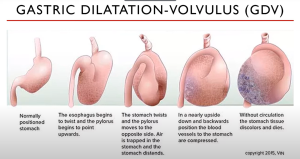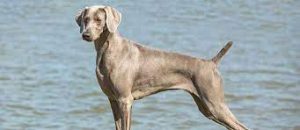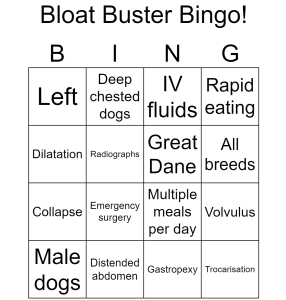135 Bloat Busters!
Authors: Sophia, Emilee, Ellie
steck130 and skadr006
Sophia Steckler, Ellie Michelsen, Emilee Skadron
Learning Objectives:
- Define Gastric Dilation and Volvulus (GDV) in dogs.
- Understand the risk factors of GDV.
- Name ways to prevent bloat/GDV in dogs.
- Understand how to treat bloat/GDV.
What is Gastric Dilation and Volvulus (GDV)?
- GDV occurs when a dog’s stomach twists clockwise on itself, causing the stomach to fill with air and cut off blood supply to the gut.
- Early stage: bloat, stomach filled with air.
- Late stage: progresses to a volvulus – the large, gas filled stomach twists in on itself so that the entrance and exit of the stomach are both blocked.
- 1-2 hours: dog goes into shock – heart rate rises, pulse gets weaker, death.

- GDV is a medical emergency! It requires urgent surgery to fix or it is fatal.
- Symptoms: swollen stomach, signs of pain around belly, retching sounds, salivation.
- Causes: still unknown. Stress may be a factor.
- Dogs most at risk: large breeds with deep chests that are older and overweight.
- Breeds most at risk: Great Danes, Saint Bernards, Weimaraners, Irish Setters, Gordon Setters, Standard Poodles, Basset Hounds, Dobermin Pinschers, Old English Sheepdogs, Golden Retrievers.
- But any dog can bloat!
- Top 3: Great Danes, Saint Bernards, Weimaraners



The Mechanics of GDV
- the distended stomach pushes the back of the rib cage, which is why the dog looks bloated and swollen. This swelling is most obvious on the left side.
- The distended, large stomach has a tendency to turn on itself, closing off the exit and entrance of the stomach and trapping all of the gas.
- The stomach is enlarged and pressed into the diaphragm and breathing becomes labored. The stomach also presses on blood vessels in the abdomen which causes problems with blood flow. All of these symptoms cause the dog to go into systemic shock.
Risk Factors Increasing Chances of Bloat
- Dogs eating one meal a day are twice as likely to experience bloat than those fed 2 meals a day!
- family history of bloat
- eating too fast
- being underweight
- having high amounts of fear, anxiety, and stress (and aggression towards people or animals)
- males are more likely to get it than females
- older dogs (above 7)
- eating moistened dry food with citric aid as an ingredient
Diagnosing Bloat
- The distended stomach will be most prominent on the left side and sound hollow like a drum when you tap it.
- Palpation (feeling) the abdominal area – dog will be painful there.
- Radiographs (X-rays) to see if the stomach is full of gas.
Link: Veterinary Exam Example
Bloat Prevention
- spread out meals throughout the day and eating 2 or more meals
- adding canned dog food into the diet
- using a slow feeder (if it won’t cause more anxiety)
- keeping a calm and relaxing environment and temperament
- dry food with calcium-rich meat meal as the first 4 ingredients in the food, for example: fish meal, lamb meal, chicken meal, bone meal
- Gastropexy – a surgical procedure that attaches the stomach to the abdominal wall to prevent it from moving. This surgery can be done as a preventative measure before GDV occurs, or at the first occurrence.
- Gastropexies (attaching the stomach to the abdominal wall) can also be performed in a few ways:
- Conventionally
- Laparoscopically (using instruments and a camera inserted through small incisions in the body wall)
- Endoscopically (using a camera and instruments inserted down the esophagus and into the stomach).
- Performing a gastropexy laparoscopically or endoscopically is less invasive but uncommon – this equipment is typically only available at specialty hospitals.
- Gastropexies (attaching the stomach to the abdominal wall) can also be performed in a few ways:

Bloat Treatment
- Treat the shock first, then perform surgery.
- GDV requires immediate action first non-surgically to stabilize the dog and then surgically.
- stabilization
- 1.Fluids are given to help reverse shock. The fluids consist of a balanced electrolyte solution.
- 2. Diagnostics (more testing) will influence whether further assistance such as blood products or a synthetic colloid (to assist in circulation and oxygen delivery to tissues) will be used.
- 3. To reduce pressure on the stomach and internal organs, the veterinarian may try to pass a stomach tube while the animal is sedated or anesthetized. They will measure the tube length and lubricate it. They will then put the gastric tube into the mouth and down to the stomach, possibly twisting slightly and cautiously to facilitate passage and get some gas out. If this does not pass smoothly, then trocharization can be done by making a hole in the skin, body wall, and stomach with a large-bore needle or over-the-needle catheter to release air.
- The next step is surgical correction.
- Surgery has 3 goals:
- 1. Reposition the abnormally positioned stomach
- 2. Evaluate the abdominal viscera and remove dead tissue when necessary
- 3. ‘tack’ the stomach to the right side of the body wall
- Surgery has 3 goals:
- Following surgery:
- The dog’s blood pressure, heart rate/rhythms, and vital signs will be monitored.
- IV fluids will continue and pain will be managed.
- In certain situations, additional treatments may need to be added such as artificial plasma or blood transfusions.
- stabilization
Bloat Buster Bingo
Instructions: Follow the link to generate a Bloat Buster Bingo Board! Each person will generate their own board, and one reader will read from the terms list attached below. As each bingo player hears a description that matches a spot on their bingo board, they can mark it off. The first person to get 4 terms in a row wins!
Link: BLOAT BUSTER BINGO



